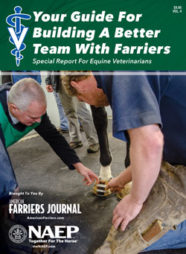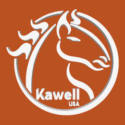Many novice horseshoers will start their careers without paying much attention to protecting themselves with insurance — and that’s a big mistake. Insurance is not a luxury for farriers — it’s a necessity.
Building Your Insurance Plan
As a hoof-care professional you need to build insurance into your business plan and the cost of insurance into the prices you charge.
While proper coverage is important, the costs can be daunting to someone just starting a hoof-care business. But the consensus of successful veteran farriers is that at the very least, you must have some sort of health coverage and proper coverage on your vehicle. Liability insurance should come next, followed by disability or income insurance.
Life insurance is also a must if you have any dependents.
The best way to get started is to sit down with a knowledgeable insurance agent and hash out what you need. If you have little or no experience with
insurance, talk to family members, friends and other farriers you know about whom they work with.
It may be a plus if an agent has already worked with other farriers. You may also find that agencies that have a history of working with farms and ranches are more familiar with what you do for a living. Either way, be aware that it is important to have a forthright discussion with agents, so they can best understand your protection needs.
You should also plan on sitting down every year with your agent and reviewing your circumstances to ensure that you have adequate coverages.
Vehicle Insurance: When Your Business Is On Wheels, You Need To Protect It Properly
Priority: High. Legally required in most states.
Price Range: Will vary greatly, depending on your state, what type of vehicle you drive, your own driving record and other factors.
Probably the biggest mistake farriers make regarding vehicle insurance is carrying personal vehicle insurance, rather than commercial. Many farriers — especially those starting out — will use the same vehicle for work that they do for personal transportation.
But if an accident occurs when you’re using your vehicle for business, you may find that your insurance company won’t pay. That’s why Esco Buff, APF, CF, Ph.D., strongly advises sitting down with an insurance agent and discussing your needs.
“The right agent can find the best deal for you,” he says. “If you’re shoeing part-time, and doing most of it near your home, you may find that your personal auto insurance will cover you. Each insurance company is a little different. Some look at the number of miles you travel in a set period of time, while others look at the percentage of use that’s for business purposes vs. personal use.”
The best way to start is by sitting down face-to-face with an insurance agent and discussing your needs.
Here are some things to remember when you look into insuring your vehicle.
- Make sure you understand how your insurance company as well as the state you’ll be working in define commercial vs. non-commercial vehicles and how your insurer defines personal vs. commercial use.
- If you will be using a shoeing trailer, make sure your insurance covers your trailer. Buff notes that one advantage trailers offer is that you can unhook it when you’re not shoeing, more clearly defining a difference between personal and business use.
- Be sure your insurance covers the cost of your vehicle’s contents — the tools and supplies. Buff says some insurance policies won’t cover fires outside of the “normal” causes such as engine compartment and electrical fires. Because you will probably be using a forge and perhaps welding equipment, find out if you need a rider for fire insurance. “I may pay a few dollars more for insurance, but my rig and truck are covered,” Buff says.
- If you’ll be hot shoeing, check into your state’s regulations on transporting propane cylinders for commercial use. If you’re not in compliance and are in an accident, you could face fines and penalties and could also find it affects your insurance coverage.
Health Coverage: A Horse Is Bigger And Stronger Than You Are, So Don’t Take Chances
Priority: High. Consider it a must.
Price Range: Will vary greatly, depending on your situation and where you live. The Kaiser Family Foundation reported that in 2011, the average annual costs of premiums for employer-supplied health care was $5,249 a month for single coverage and $15,073 for family coverage. A 2011 report by eHealth Insurance Inc., which surveys individually purchased plans, reported the average cost was $2,196 a year ($183 a month) for single coverage and $4,968 ($414 a month) for family coverage.
The national picture on health care remains confusing as the political debate continues over federal health care policy. Exactly how it all shakes out in the marketplace isn’t yet clear. But there’s no debate about the importance of hoof-care professionals having health insurance.
“It’s crazy to do what we do for a living, to expose ourselves to the danger from doing it without health insurance,” says Jeff Ridley, president of the American Association of Professional Farriers.
Ridley, from Leighton, Iowa, did some research on trying to put together a health insurance package for the American Farriers Association several years ago. From that experience, he knows it’s important to check out individual rules and regulations for the state you live in.
“The big thing is that every state has its own regulations and restrictions,” he recalls. “So it’s important to do your homework. But you have to take care of yourself and your family.”
Here are some avenues for obtaining coverage.
- Some multi-farrier businesses offer health coverage, but these are rare. Even if a more experienced farrier agrees to take you on in an apprenticeship, it would be highly unusual to get health coverage in such a relationship (although you may — and should — be covered for workers’ compensation).
- Get coverage through another employer: This could be through a spouse’s job, or another job of your own. A number of farriers have reported doing this while shoeing part-time as they get established.
- Recent legislation allows young adults under the age of 26 to remain on their parent’s coverage. This may be an option for many young farriers. You can also offer to help them by paying toward the coverage from your income.
- Another possibility is to look into health-care plans that you may be eligible for through your state. All states have some sort of subsidized basic health-care plan. As a self-employed farrier, you may be eligible to enroll in the plan, which typically offer participants lower co-pays than most private plans. Benefits, eligibility requirements and payments will vary greatly from state to state. Be aware that in the current economic downturn, some states are tightening eligibility requirements or not adding new participants. You’ll have to see what your own state is doing.
- Private plans are also available. Ultimately, this is what many farriers will have to rely on. This is often a fact of life for those who choose to “be their own boss.” It also means you get to pay for your own benefit’s package.
- Ask an agent about higher-deductible plans. Most private insurers offer these. The plans cost less up front, but you’ll pay most expenses yourself until you reach the amount specified in your particular plan. The key concept with these plans is that you will have coverage beyond that amount if you suffer a major injury.
Liability Coverage: When Things Go Wrong And Someone Or Something Gets Hurt
Priority: Moderate to High. Just below health insurance and proper vehicle insurance.
Price Range: $450 and up a year.

Bent and gnarled fingers are just one of the hazards hoof-care professionals face. Having proper insurance coverage for injuries simply makes sense.
Liability coverage is a tricky issue. Many young farriers probably feel they can go without it because they have few assets.
Red Renchin, the International Horseshoeing Hall Of Fame member from Mequon, Wis., says many young shoers will work without liability insurance.
“I know I did,” Renchin admits. “It wasn’t really until I had some equity built up in my business that I started worrying about someone coming after it.”
Some novice farriers may think they don’t need liability insurance because they’ll be working on backyard horses, that aren’t of particularly high value. But Dr. Lance Allen, director of the Equine Division in the Kansas City, Mo., office of Markel Insurance, advises against thinking that way.
“A person can be hurt just as badly by a $50 horse as they can by a $500 horse,” he says. “You don’t want to think that just because you’re working on inexpensive horses, you don’t need protection. What if a 12-year-old girl is holding the horse and it takes off? She could have a million-dollar injury.”
Markel, headquartered in Glen Allen, Va., Farm Family Insurance of Albany, N.Y., Veracity Insurance Solutions of Pleasant Grove, Utah, and Ark Agency of Painsville, Minn., are among firms that offer specific farrier liability insurance packages. Other insurance
companies may be able to put together specific packages for your needs. Markel’s website (www.markelinsurance.com) offers an idea of what kind of protection such policies provide. Basically, these policies protect the farrier in the event he or she is sued for bodily injury and/or property damage. Terms of coverage — such as specific coverages and limits — are spelled out in individual policies.
Broad areas and terms of interest include:
- General Liability: Includes cost of legal defense.
- On and Off Premises: Protection against claims due to bodily injury or property damage caused by a farrier’s activities, regardless of where it occurred.
- Completed Operations: Coverage for bodily injury or property damage caused by the work the farrier has performed. (For example, a shoe comes off, resulting in injuries to a horse or rider).
- Care, Custody and Control Liability: Coverage for injury to a horse while it is in your care, custody and control.
- Equipment and Supplies Floater. Provides coverage for loss or damage to a farrier’s transportable inventory, such as tools, shoes and supplies.
Allen points out that Markel offers a liability policy for as little as $450 a year, which can be paid through a series of installments. That’s not a lot of money when you consider what could happen to you.
Disability Insurance: Because The Bills Keep Coming, Even If You Can’t Work
Priority: Moderate (but higher, if you are providing all the income for your family).
Price Range: Most estimates are between 1% and 3% of your average annual income.
Disability insurance is another area you may want to consider. Mike Ehlert, a veteran farrier from Hartford, Wis., is a big believer in disability insurance. Twice in the last decade, Ehlert has been unable to shoe for extended periods of time after breaking a leg. He credits his overall insurance package with protecting him and his family from financial disaster.
Ironically enough, Ehlert was not shoeing horses at either time when he broke his leg. The first break occurred in 2001 during a boating accident. The second one occurred in 2008 when he suffered a bad fall on ice while getting ready to leave his house for a day’s shoeing.
“When I was laying there waiting for the ambulance, I wasn’t as stressed as I was 7 years ago,” he recalls. “Just having the insurance and knowing how things worked made things much less stressful.”
Ehlert has two different disability policies. One started paying when he’d been out of work for 30 days. The other kicked in 60 days later.
Ehlert points out that working with an agent to put together an overall insurance package paid off for him. He had health insurance coverage for himself and his family and his disability coverage provided an income while he was unable to work.
“You have to think about your situation,” he emphasizes. “If I’d been an accountant, I probably would have only missed a day or so of work. But you can’t shoe horses with a broken leg.”
This is a situation where you really need to look at your individual needs. Start by sitting down and calculating what your monthly bills are. Take all your sources of income into consideration and how much you have in savings that you can tap in the event of an injury. You’ll need this information to decide what levels of insurance you want, and how soon after you are out of work you want payments to start.
Ehlert says with young farriers starting out, he’d agree that proper vehicle insurance and health insurance should be the first priorities. He also says life insurance is important if you have a family.
“After that, I’d probably look at disability insurance,” he says. Ehlert is also a big fan of sitting down with independent insurance agents and reviewing your insurance coverage regularly.
“As your situation changes, your insurance needs change,” he notes. “It’s important to make sure you have the coverage you’ll need.”
Some Things To Consider:
- Talk with an insurance agent about an overall business package. You may be able to get an “umbrella” policy that covers vehicle, liability and disability for a lower price than you get by buying each individually.
- Professional organizations often offer insurance as a member benefit. Markel offers a discount in liability insurance to members of the American Farrier’s Association (AFA) and the American Association Of Professional Farriers (AAPF), with additional discounts available to AAPF members who pursue additional education. The AFA also covers all members with a $50,000 accidental death and dismemberment policy, and offers discounts on AFLAC secondary insurance. Look into local equine, agricultural and business organizations as well.
- Many insurance premiums can be used as tax deductions.
- Do your homework and make sure you understand what is and isn’t covered under all of your policies. Veteran farrier Brian Robertson of Osseo, Mich., told an International Hoof-Care Summit audience, “You should know an insurance agent on a first-name basis. It doesn’t cost anything to talk to an insurance agent.”







